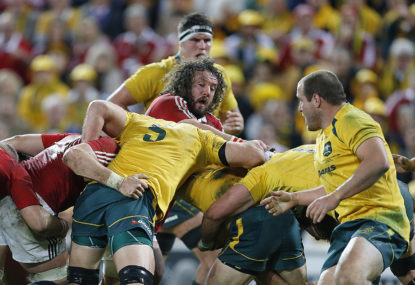The Wallaby props have copped a lot of flak for not being good enough in recent weeks, but it can be argued it’s a poor second row, not the props, which are the cause of Australia’s scrumming woes.
I would also suggest the All Blacks – who struggled against the Argentinians – are in danger of being taken apart by the Springbok scrum, because of the type of locks the teams in Australia and New Zealand have cultivated in recent years.
During my years of playing rugby at school and first XV in South Africa, as a lock we were always referred to as the engine room – the powerhouse of the scrum.
South Africa prized power and technique from its second row. I am only 1.88 metres tall, but played lock because I have calves almost as big as my thighs and had good explosive power (it was also, of course, just club level).
In recent years this focus has become diluted by a demand for more mobile locks, particularly in Australia and New Zealand.
The Antipodean preoccupation with running rugby has meant a shift to locks like Sam Whitelock and Luke Romano.
These locks are chosen because of their diverse skills base, including their line-out skills, but more for their ability to range as a second set of loose forwards and even as extra options out wide.
In the past you could have argued props were the cause of a team’s scrumming woes because the front row battle was what scrums had been reduced too.
In fact, in recent times we’ve often heard calls for the scrums to be scrapped. The feeling was they had passed their use-by-date and were boring (for good reason).
They were set piece token gestures, a way to get the ball into circulation after play had broken down – like a league scrum, which can be described, at best, as a thing of convenience.
The scum-half/halfback was allowed to feed the ball almost under the feet of his locks and the ball was cleared as fast as humanly possible. It just wasn’t a contest.
The hooker’s ability to hook, and power of the second row and in particular their technique, was supplanted by an almost unhealthy focus on propping technique – balance was lost and the scrums were so one-dimensional in their front row focus they literally caved in.
It was a circumstance that suited smaller, wily props and left far too much open to the referee’s interpretation. This meant other work had to be found for the locks.
Again, locks were further sidelined – particularly last year – by a penchant to keep the ball in play, and so starve sides that specialised in the set piece i.e. South African and Argentina.
This week Ewen McKenzie said he knew South Africa would prize the set pieces and the Wallabies would have to limit those.
It was old thinking that did not take into account the new scrum laws (until now, New Zealand and Australia had only played each other under the new laws, which was a case of like-versus-like).
South Africans however, in the vein of Bakkies Botha and Eben Etzebeth, continued to focus on power and second-row technique, utilising their powerful locks more in enforcer roles than ranging roles.
South African locks held a limited profile except for the lineout, i.e. Victor Matfield, and when, in all likelihood, being carded for clearing out a ruck with a bit too much enthusiasm, i.e. Bakkies Botha.
The new scrum rules have restored balance to the scrum in terms of workload.
Scrums are taking up to or more than 50 per cent longer to clear. And that is key – scrums are longer, therefore the game is slower.
Slower scrums mean the engine room once again has to work massively harder. Ranging locks can no longer break up and run, as they have been used to in recent years.
Suddenly they’re in a cauldron and they don’t like it.
The apparent dominance this year of the Springbok and Puma scrums is because both nations have eschewed the running game in favour of an almost cultural pride in power and scrumming well (their traditional strengths).
We forget however these were also traditional strengths of the All Blacks in years past – not that they are that far off.
Flip van der Merwe, Eben Etzebeth and Juandre Kruger are better tight forwards than ‘ranging’ forwards. The Springboks have instead used the likes of their hookers, in Bismarck du Plessis and Adriaan Strauss, as their second set of loose forwards.
Etzebeth, in particular, has the potential to be the best lock South African has ever produced. He is power personified; an enforcer, rapidly becoming Matfield’s equal in the lineout and it would appear a superb scrummager.
It’s not like South Africa or the Pumas anticipated the outcome of the new scrum laws, it’s that the new laws are better suited to the Pumas and Springboks game – slower scrums, slower game.
The days of ranging locks like Samuel Whitelock, Luke Romano and Rob Simmons are numbered unless they improve their scrum technique.
James Horwill, Kane Douglas, Scott Fardy and potentially Brodie Retallick, however, may well be about to discover a whole new world.





























































































